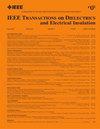Pulse Charging–Discharging Behavior and Reliability Analysis of Antiferroelectric MLCCs
IF 2.9
3区 工程技术
Q2 ENGINEERING, ELECTRICAL & ELECTRONIC
IEEE Transactions on Dielectrics and Electrical Insulation
Pub Date : 2024-12-17
DOI:10.1109/TDEI.2024.3519075
引用次数: 0
Abstract
In this research, the pulse charging-discharging behavior and reliability of antiferroelectric multilayer ceramic capacitors (AFE MLCCs) were investigated. The results revealed that as the voltage stress increased gradually from 900 to 1400 V, the characteristic lifetime of AFE MLCCs exhibited a monotonically decreasing trend, and this downward trend conforms to an inverse power law. However, experimental findings reveal that the discharge lifetime of AFE MLCCs is longer at higher temperatures. Moreover, the relationship between lifetime and temperature stress no longer follows the Arrhenius accelerated model, which may be attributed to the different phase transition behaviors of AFE MLCC at elevated temperatures. By observing the results at high temperatures, it was found that the polarization of AFE MLCC significantly decreased, leading to a reduction in its stored energy density and discharge current. Furthermore, high temperatures also decreased the strain caused by structural transitions in AFE MLCC, indicating a more complex influence of temperature on the phase transition behavior of AFE materials. Finally, microfailures of AFE MLCC were observed, and the failure mechanism was analyzed, categorizing it into three types. In addition, it was noted that due to the phase transition behavior of AFE materials and the inherent complex internal structure of MLCC, the breakdown failure of AFE MLCC is a complex mechanical-electrical–thermal coupling phenomenon, which needs to be a key point for future practical applications of AFE MLCCs.反铁电mlcc脉冲充放电特性及可靠性分析
本文研究了反铁电多层陶瓷电容器(AFE mlcc)的脉冲充放电特性和可靠性。结果表明,在900 ~ 1400 V电压应力范围内,随着电压应力的逐渐增大,AFE mlcc的特征寿命呈现单调减小的趋势,且这种减小趋势符合反幂律。然而,实验结果表明,AFE mlcc在较高温度下的放电寿命更长。此外,寿命与温度应力之间的关系不再遵循Arrhenius加速模型,这可能与AFE MLCC在高温下的不同相变行为有关。在高温下观察结果发现,AFE MLCC的极化度明显降低,导致其存储能量密度和放电电流降低。此外,高温还降低了AFE MLCC中由结构转变引起的应变,表明温度对AFE材料相变行为的影响更为复杂。最后对AFE MLCC进行了微失效观察,并对其失效机理进行了分析,将其分为三种类型。此外,由于AFE材料的相变行为和MLCC固有的复杂内部结构,AFE MLCC击穿失效是一种复杂的机-电-热耦合现象,这需要成为AFE MLCC未来实际应用的重点。
本文章由计算机程序翻译,如有差异,请以英文原文为准。
求助全文
约1分钟内获得全文
求助全文
来源期刊
CiteScore
6.00
自引率
22.60%
发文量
309
审稿时长
5.2 months
期刊介绍:
Topics that are concerned with dielectric phenomena and measurements, with development and characterization of gaseous, vacuum, liquid and solid electrical insulating materials and systems; and with utilization of these materials in circuits and systems under condition of use.

 求助内容:
求助内容: 应助结果提醒方式:
应助结果提醒方式:


